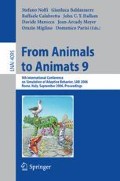Abstract
This paper investigates the dynamics of cumulative cultural evolution in a simulation concerning the evolution of language. This simulation integrates the iterated learning model with the Talking Heads experiment in which a population of agents evolves a language to communicate geometrical coloured objects by playing guessing games and transmitting the language from one generation to the next. The results show that cumulative cultural evolution is possible if the language becomes highly regular, which only happens if the language is transmitted from generation to generation.
This study has been supported by an EC Marie Curie fellowship and a VENI grant funded by the Netherlands Organisation for Scientific Research (NWO).
Access this chapter
Tax calculation will be finalised at checkout
Purchases are for personal use only
Preview
Unable to display preview. Download preview PDF.
References
Darwin, C.: The Origin of Species. John Murray, London (1959)
Boyd, R., Richerson, P.: The origin and evolution of cultures. Oxford University Press, Oxford (2005)
Cavalli-Sforza, L.L., Feldman, M.W.: Cultural Transmission and Evolution: A quantitative approach. Princeton University Press, Princeton (1981)
Croft, W.: Explaining Language Change: An evolutionary approach. Longman, Harlow (2000)
Wray, A.: Protolanguage as a holistic system for social interaction. Language and Communication 18, 47–67 (1998)
Kirby, S., Smith, K., Brighton, H.: From UG to universals: linguistic adaptation through iterated learning. Studies in Language 28(3), 587–607 (2004)
Vogt, P.: The emergence of compositional structures in perceptually grounded language games. Artificial Intelligence 167(1-2), 206–242 (2005)
Deacon, T.: The Symbolic Species. W. Norton and Co., New York (1997)
Vogt, P.: On the acquisition and evolution of compositional languages: Sparse input and the productive creativity of children. Adaptive Behavior 13(4), 325–346 (2005)
Vogt, P.: Stability conditions in the evolution of compositional languages: issues in scaling population sizes. In: Bourgine, P., Képès, F., Schoenauer, M. (eds.) Proceedings of the European Conference on Complex Systems, ECCS 2005 (2005)
Batali, J.: The negotiation and acquisition of recursive grammars as a result of competition among exemplars. In: Briscoe, E. (ed.) Linguistic Evolution through Language Acquisition: Formal and Computational Models, pp. 111–172. Cambridge University Press, Cambridge (2002)
Steels, L., Kaplan, F., McIntyre, A., Van Looveren, J.: Crucial factors in the origins of word-meaning. In: Wray, A. (ed.) The Transition to Language. Oxford University Press, Oxford (2002)
De Beule, J., Bergen, B.K.: On the emergence of compositionality. In: Cangelosi, A., Smith, A., Smith, K. (eds.) The Evolution of Language: Proceedings of the 6th International Conference on the Evolution of Language (2006)
Baronchelli, A., Loreto, V., Dall’Asta, L., Barrat, A.: Bootstrapping communication in language games: Strategy, topology and all that. In: Cangelosi, A., Smith, A., Smith, K. (eds.) Proceedings of Evolang, vol. 6. World Scientific Publishing, Singapore (2006)
Edelman, G.M.: Neural Darwinism. Basic Books Inc., New York (1987)
Tamariz, M.: Evolutionary dynamics in language form and language meaning. In: Cangelosi, A., Smith, A.D.M., Smith, K. (eds.) The Evolution of Language: Proceedings of the 6th International Conference on the Evolution of Language. World Scientific Press, Singapore (2006)
Author information
Authors and Affiliations
Editor information
Editors and Affiliations
Rights and permissions
Copyright information
© 2006 Springer-Verlag Berlin Heidelberg
About this paper
Cite this paper
Vogt, P. (2006). Cumulative Cultural Evolution: Can We Ever Learn More?. In: Nolfi, S., et al. From Animals to Animats 9. SAB 2006. Lecture Notes in Computer Science(), vol 4095. Springer, Berlin, Heidelberg. https://doi.org/10.1007/11840541_61
Download citation
DOI: https://doi.org/10.1007/11840541_61
Publisher Name: Springer, Berlin, Heidelberg
Print ISBN: 978-3-540-38608-7
Online ISBN: 978-3-540-38615-5
eBook Packages: Computer ScienceComputer Science (R0)

